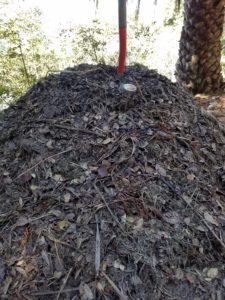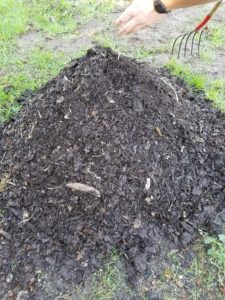
02 Jun Understanding Composting and Compost Tea
Understanding Compost and Compost Tea
What is Compost?
Compost is decomposed organic material taken from kitchen scraps or from
green waste around the garden. The scraps and green waste are collected together for
a controlled decomposition into useable nutrient rich soil and fertilizer. At our current
rate of refuse the EPA currently states that yard waste and kitchen scraps currently take
up nearly a third of the material dumped in landfills. 1 This material can easily be kept on
site and turned into viable and extremely beneficial soil. The waste and kitchen scraps
are mostly broken down through an aerobic organic bloom of beneficial bacteria and
fungi. The bacteria and fungi are the actual workers on a microscopic scale. They are
transforming the spent plant material into a nutrient rich soil through their natural
ingestion of that waste material.

freshly turned compost pile
To make compost you need a combination of brown and green material. The
terms brown and green refer to the major nutrients in the structure that can generally be
defined in the plant through color. The terms brown and green refer to the material high
in nitrogen being green, with organic matter high in carbon being brown. These
organisms require a balance of air (oxygen), water, carbon and nitrogen; a 3:1 ratio of
brown:green material (C:N) is desired to provide the right environment for these
organisms to thrive. With a compost pile active and running properly it can be churning
out fresh completely composted soil in 1-3 months.
Types of Composting
Hot Composting
The most common form of composting and can be achieved through a number of
different methods with the same result. Most commonly purchased are composting bins,
these assure that animals like raccoons will not go searching through your compost yet
they often create problems due to inadequate airflow or simply having the airflow
clogged up creating an anaerobic environment that is now detrimental to the landscape
you are attempting to help. Apart from these are the open structures these are set in a
4’x4’ or larger box with no lid made from cinder brick/wood and simply piled in. For the
least maintenance and start-up fees a hot compost pile can be started without a
surrounding structure either as a standalone or a windrow pile (one large pile that is set
in a line).

Compost pile freshly turned and watered
For this, the materials that are collected on site are organized into a
thoroughly mixed pile, then add water. With weekly turning of these unsupported piles
they can be the most efficient at creating new soil due to uninhibited airflow throughout
the compost pile. Since 2009 Santa Barbara has been contracting out green waste to
Agromin for them to use large scale hot composting in order to reduce the amount of
materials that make it to landfills. Agromin employs a hot composting method without a
surrounding structure called a windrow pile, generally 4 to 8 feet high and from 14 to 25
feet long. This style is more common with commercial endeavors who have access to a
lot of material and land. The residential option of this commercial style is the
stand-alone static compost pile averaging 4 feet by 4 feet.
Cold Composting/Bokashi
This is a generally small batch apartment geared style of composting that
actually uses an anaerobic organism to break down the food scrap material. The
material is sealed in a bag or bin and inoculated with bran, barley or wheat that has
already been fermented to bring the desired microbes. The sealed mixture is then left in
a cool dark place for 3-6 months to let it ferment. At the end of this process the
fermented liquid can be used as a fertilizer and the plant/food material can be added to
a hot compost pile or left outside for 2-7 days to let aerobic microbes to finish the
decomposition.
Vermiculture
The process of Vermiculture, or a worm bin is simply raising composting red
wigglers at home, either indoors or outside. There are four main ‘ingredients’ to your
worm bin:
1. Container/Bin. (the actual housing unit or bin can be made at home, or
purchased [the Worm Farm 360® is currently used by Dave’s Organic Gardening
on site in the upper mission district of Santa Barbara]).
2. Bedding materials. generally a mixture of shredded newspaper or unbleached
paper, wood chips/shavings, sawdust, coco coir, pumice, aged leaves, peat
moss, and the most common favorite being shredded cardboard.
3. Waste Materials/Worm Food. These are your kitchen scraps, items that your
worms will thrive in are vegetable and fruit waste, especially in squash or melons,
crushed eggshells, coffee grounds & filters, tea bags, and starchy foods like
breads and pasta. However there are a few items to avoid including into your
worm bin as they will slowly poison your colony or will be simply left untouched
by the worms. These items to avoid are human/pet waste(livestock manure that
has been aged is exempt), non-biodegradable materials/plastics, mechanical
oils/grease, and dairy.
4. The final Ingredient, your worms!

Red wigglers found in our compost pile
Eisenia fetida (Red wigglers) is the most commonly cultivated species, 2 however this species is not the most common one that you will find
when digging through your garden, they prefer living in massed colonies and
aged manure piles or areas that are high in nutrients that naturally produce heat
through organic blooms that have not been disturbed for some time. (Worms can
be ordered here or through amazon.)
If these 4 ingredients are maintained properly your worms can easily transform
your food scraps into useable worm castings nearly identical to the castings sold by the
bag at garden supply stores. Under perfect laboratory settings scientists were able to
achieve a a feeding rate of 1.25 kg-feed/kg-worm/day from a stock (starting) density of
1.60 kg-worms/m 2 (0.33 lb-worms/ft 2 ) this had resulted in the highest bioconversion of
the substrate into earthworm biomass (worm castings). 3 This example means under
perfect settings these animals can consume nearly their entire body mass in a day.
Additional uses of Compost
Compost Tea
Compost tea is an aqueous solution of microbes that have been extracted from
the compost and brewed for 24-48 hours to have the microbes bloom in the aqueous
solution. This brewing process promotes the growth of beneficial microbes that aid the
plant in sequestration of nutrients and aids the plant in the intake of water. In addition
these microbes help the plants immune system to reduce the use of localized harsh
chemical insecticides. Compost tea can be applied through a simple root drench or
foliar spray, with the root drench you are achieving more through increase of mineral
intake of the plant while the foliar application boosts the plants immunity predominantly.

Aerated compost tea
At the current time Dave’s Organic Gardening is the only company brewing compost tea
for retail sale in Santa Barbara County.

Actively aerating compost tea.
How can Composting help you?
First and foremost Compost can save you money, with a creation of nutrients and
fertilizers through the compost eliminating the need for harsh chemical nutrients. In
addition, applications of compost and compost tea can boost the plant’s natural immune
system reducing the issue of pests and eliminating the need for harsh insecticides that
are known to cause human harm. 4 Composting can simply help save additional
expenses around your garden by creating them there yourself and removing the need to
purchase chemicals that could cause yourself harm.
Dylan Yeiser-Fodness
Works Cited
1 United States Environmental Protection Agency. Composting at Home . EPA.gov March 20,
2017. https://www.epa.gov/recycle/composting-home
2 Bentley. Red Worm Composting “Getting Started”. Red Worm Composting.
3 Ndegwa, P.m, et al. “Effects of stocking density and feeding rate on vermicomposting of
biosolids.” Bioresource Technology , vol. 71, no. 1, 2000, pp. 5–12.,
doi:10.1016/s0960-8524(99)00055-3.
4 Government of Canada, Canadian Centre for Occupational Health and Safety. “Pesticides –
Health Effects : OSH Answers.” Government of Canada, Canadian Centre for
Occupational Health and Safety , Government of Canada, 9 Feb. 2018,
www.ccohs.ca/oshanswers/chemicals/pesticides/health_effects.html



Sorry, the comment form is closed at this time.